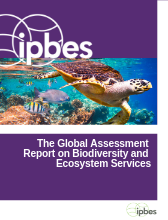IPBES Global Assessment
IPBES Global Assessment Report on Biodiversity and Ecosystem Services / May 2019
 This landmark report by the Intergovernmental Science-Policy Platform on Biodiversity and Ecosystem Services (IPBES) warns that species extinction rates are accelerating with 1 million species at risk of disappearing over the next 30 years. This decline is dangerous and unprecedented.
This landmark report by the Intergovernmental Science-Policy Platform on Biodiversity and Ecosystem Services (IPBES) warns that species extinction rates are accelerating with 1 million species at risk of disappearing over the next 30 years. This decline is dangerous and unprecedented.
“The average abundance of native species in most major land-based habitats has fallen by at least 20%, mostly since 1900. More than 40% of amphibian species, almost 33% of reef forming corals and more than a third of all marine mammals are threatened.”
“The picture is less clear for insect species, but available evidence supports a tentative estimate of 10% being threatened. At least 680 vertebrate species had been driven to extinction since the 16th century and more than 9% of all domesticated breeds of mammals used for food and agriculture had become extinct by 2016, with at least 1,000 more breeds still threatened.”
“While more food, energy and materials than ever before are now being supplied to people in most places, this is increasingly at the expense of nature’s ability to provide such contributions in the future and frequently undermines nature’s many other contributions, which range from water quality regulation to sense of place. The biosphere, upon which humanity as a whole depends, is being altered to an unparalleled degree across all spatial scales. Biodiversity – the diversity within species, between species and of ecosystems – is declining faster than at any time in human history.”
It was written by 145 authors from 50 countries. It covers changes over the last 50 years and presents several scenarios for the future. The report is comprehensive in scope and based on 15,000 scientific and governments sources. Crucially is also based on indigenous knowledge and recognises that whilst nature in indigenous areas is increasingly under pressure that : “Nature is generally declining less rapidly in indigenous peoples’ land than in other lands, but is nevertheless declining, as is the knowledge of how to manage it. At least a quarter of the global land area is traditionally owned, managed, used or occupied by indigenous peoples.”
In terms of the causes of accelerating species extinction the report finds that this is directly a result of human activity in the following overlapping ways:
- changes in land use (mainly from agricultural expansion and rapid urbanisation) and sea use (overexploitation fish and shellfish),
- exploitation of organisms (e.g. harvesting, logging, hunting and fishing),
- invasive alien species,
- pollution of air, land and water
- emissions of greenhouse gases that are causing climate change.
Overall the type of economic model is at the heart of all this: “Economic incentives generally have favoured expanding economic activity, and often environmental harm, over conservation or restoration.”
For example: “Harmful economic incentives and policies associated with unsustainable practices of fisheries, aquaculture, agriculture (including fertilizer and pesticide use), livestock, forestry, mining and energy (including fossil fuels and biofuels) are often associated with land/sea-use change and overexploitation of natural resources, as well as inefficient production and waste management. Vested interests may oppose the removal of subsidies or the introduction of other policies.”
The report recommends “the evolution of global financial and economic systems to build a global sustainable economy, steering away from the current limited paradigm of economic growth” and highlights that it is possible for “opposition from vested interests can be overcome for public good”
IPBES press release
Summary of IPBES Global Assessment
————————————
This summary was prepared by Why Green Economy?. The views expressed have been paraphrased. See the original source for more information.

Leave a Reply